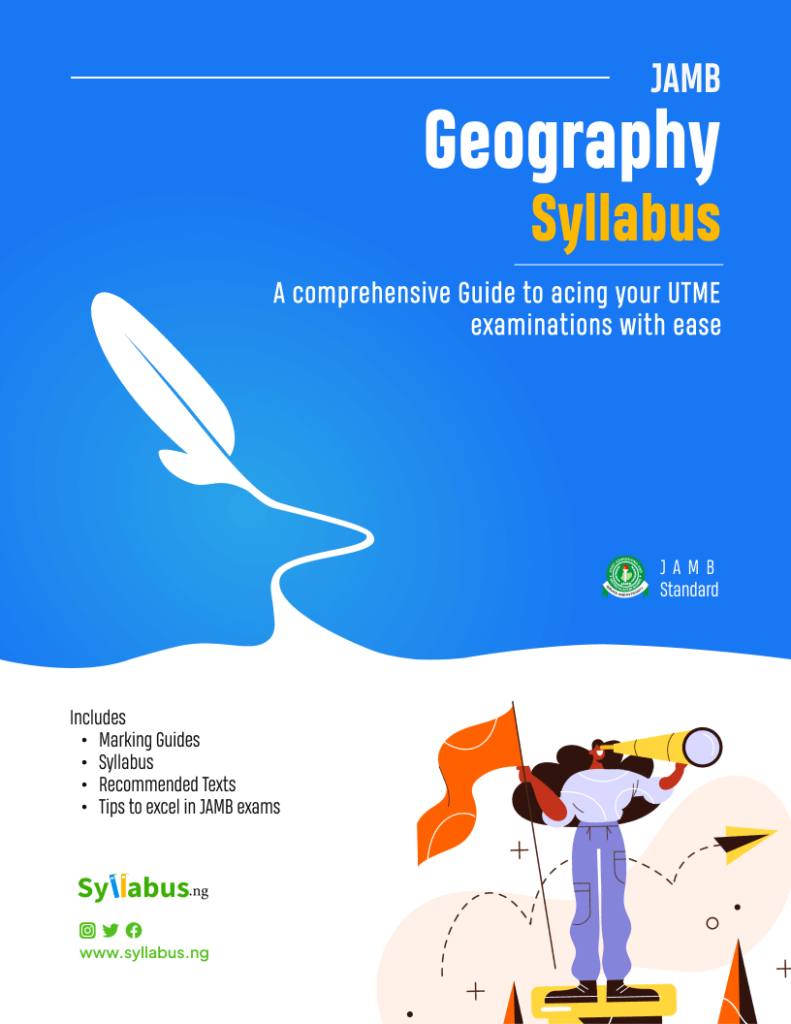JAMB Geography Syllabus
Ace your JAMB geography exams. Don’t waste your time by reading without direction! Download this UTME Syllabus for geography to study smart and excel.

Home » JAMB Syllabus » JAMB Geography Syllabus
Home » JAMB Syllabus » JAMB Geography SyllabusWriting JAMB Geography Exam
The syllabus covers all you are expected to see in your examinations, including physical and human geography, the environment, economic activities, settlement, and more.
Having the syllabus will equally inform you of what you’re expected to know from each of the topics.
Geography is a must if you are hoping to study courses like Geography, Metallurgical Science, Aeronautics and other environmental science-related courses
The recommended texts for the exam are also outlined below
Objective
The aim of the Unified Tertiary Matriculation Examination (UTME) 2024 syllabus in Geography is to prepare the candidates for the Board’s examination. It is designed to test their achievement of the course objectives, which are to:
- Handle and interpret topographic maps, photographs, statistical data and diagrams, and basic field survey;
- Demonstrate knowledge of man’s physical and human environment and how many lives and earns a living on earth surface with special reference to Nigeria and Africa;
- Show understanding of the interrelationship between man and his environment;
- Apply geographical concepts, skills, and principles to solving problems.
- Understand fieldwork techniques and the study of a local area in the field.
Download JAMB Recommended Geography Syllabus

Excelling your JAMB Geography exam starts from knowing what’s expected of you.
Don’t be left behind. Download the Syllabus today.
Detailed JAMB Economics Syllabus
| JAMB GEOGRAPHY SYLLABUS | ||
|---|---|---|
| SN | TOPICS | OBJECTIVES |
| 1 | PRACTICAL GEOGRAPHY | |
| A. Maps B. Scale and measurement: distances, areas reduction and enlargement, directions, bearings, and gradients with reference to topographical maps C. Map reading and interpretation; drawing of cross profiles, recognition of intervisibility, recognition, and description of physical and human features and relationship as depicted on topographic maps. D. Interpretation of statistical data; Maps and diagrams E. Elementary Surveying; Chain and prismatic. Open and close traverse. Procedure. Problems. Advantages and disadvantages. F. Geographic Information System (GIS): Components. Techniques. Data. Sources. Applications | Candidates should be able to: i. define and identify different types and uses of maps Candidates should be able to: i. apply the different types of scale to distances and area measurement; ii. apply the knowledge of scale to gradients, map reduction, and enlargement. Candidates should be able to: i. illustrate the relief of an area through profile drawing; ii. interpret physical and human features from topographical maps. Candidates should be able to: i.Compute quantitative information from statistical data, diagrams, and maps, ii. interpret statistical data, diagrams, and maps. Candidates should be able to: i. analyze the principle and procedure of each technique; ii. compare the advantages of the two techniques. Candidates should be able to: i. Understand GIS and its uses. ii. Understand the computer system of data capturing and analysis iii. Express locations through the use of latitudes, longitudes, zip codes etc. iv. Understand land surveying, remote sensing, map digitizing, map scanning as sources of data. v. Explain areas of use: Defense, Agriculture, Rural Development etc. vi. Identify problems with GIS in Nigeria. | |
| 2 | PHYSICAL GEOGRAPHY | |
| A. The earth as a planet The earth in the solar system, rotation and revolution; The shape and size of the earth Latitudes and distances, longitudes and time. B. The Earth Crust The structure of the earth (internal and external) Relationships among the four spheres. Rocks: Types, characteristics, modes of formation and uses Earth’s movement: Tectonic forces Major Landforms: Mountains, Plateaux, Plains, Coastal landforms, karst topography and desert landforms. C. Volcanism and Earthquakes landforms associated with volcanic activities Landforms of Igneous Rocks origin and types of Volcanoes some volcanic eruptions and earthquakes. D. Denudation processes in the tropics weathering erosion mass movement deposition E. Water Bodies Oceans and seas (world distribution, salinity, and uses) Ocean currents – types, distribution, causes, and effects; Lakes – types, distribution and uses. Rivers: Action of running water. F. Weather and Climate: Concept of weather and climate Elements of weather and climate Factors controlling weather and climate (pressure, air mass, altitude, continentality, and winds) Classification of climate (Greek and Koppen). Major climate types (Koppen), their characteristics, and distribution. Measuring and recording weather parameters and instruments used. The basic science of climate change. G. Vegetation Factors controlling growth of plants The concept of vegetation e.g. plant communities and succession Major types of vegetation, their characteristics and distribution, Impact of human activities on vegetation. H. Soils Definition and properties Factors and processes of formation Soil profiles Major tropical types, their characteristics, distribution and uses; Impact of human activities on soils. I. Environmental Resources; Types of resources (atmospheric, land, soil, Vegetation and minerals) The concept of renewable and non- renewable resources. J. Environmental interaction: Land ecosystem Environmental balance and human interaction K. Environmental hazards: Natural hazards (droughts, earthquakes, volcanic eruptions, flooding) Man-induced (soil erosion, deforestation, pollution, flooding and desertification) Effects, prevention and control of hazards. L. Environmental Conservation | Candidates should be able to: i. identify the relative positions of the planets in the solar system; ii relate the effects of the rotation to the revolution of the earth; iii provide proof for the shape and size of the earth; iv differentiate between latitudes and longitudes; v relate lines of latitude to calculation of distance; vi relate lines of longitude to calculation of time Candidates should be able to: i. compare the internal and external components of the earth. ii. understand the existing relationship among the atmosphere, biosphere in terms of energy balance and water cycle. iii. differentiate between major types of rocks and their characteristics; iv. analyze the processes of formation and the resultant features; v. indicate the uses of rocks. vi. differentiate between tensional and compressional forces and the resultant landforms. vii. identify and describe the major landforms. Candidates should be able to: i. explain the processes of volcanic eruptions and earthquakes ii. describe the different landforms associated with both volcanic eruptions and earthquakes. iii. give examples of major volcanic eruptions and earthquakes in the world. Candidates should be able to: i. identify the agents of denudation ii. associate landforms with each process and agent. Candidates should be able to: i. locate oceans and seas on the globe; ii. examine the characteristics and uses of oceans and seas; iii. classify the types of ocean currents; iv. account for the distribution of ocean currents; v. evaluate the causes and effects of ocean currents; vi. identify the types and location of lakes; vii. indicate the characteristics and uses of lakes viii. identify the landforms of the different stages of a river course. Candidates should be able to: i. differentiate between weather and climate; ii differentiate between the elements of weather and climate; iii isolate the factors controlling weather and climate; iv compare Koppen’s and Greek’s classifications v identify the major types of climate according to Koppen; vi relate the weather instruments to their uses. vii define climate change viii understand the causes of climate change I understand the effects and remedies of climate change. Candidates should be able to: i. trace the factors controlling the growth of plants; ii analyze the process of vegetation development; iii identify the types, their characteristics and distribution; iv assess the impact of human activities on vegetation. Candidates should be able to: i. classify soils and their properties; ii. isolate the factors of formation; iii. differentiate between the different types of soil horizons and their characteristics; iv. compare the major tropical soil types and uses of soils; v. account for the distribution and uses of soils; vi. assess the impact of human activities on soils. Candidates should be able to: i. interpret the concept of environmental resources; ii. relate environmental resources to their uses; iii. differentiate between the concepts of renewable and non-renewable resources. Candidates should be able to: i. identify the components of land ecosystem; ii. establish the interrelationship within the ecosystem; iii. interpret the concept of environmental balance; iv. analyze the effects of human activities on the land ecosystem. Candidates should be able to: i. identify the natural hazards and their causes; ii. relate the human-induced hazards to their causes; iii. locate the major areas where they are common and their effects; iv. recommend possible methods of prevention and control. Candidates should be able to: i. Explain with examples environmental conservation ii discuss the different methods of environmental conservation. iii Explain the need/importance of environmental conservation | |
| 3 | HUMAN GEOGRAPHY | |
| A. Population: World population with particular reference to the Amazon Basin, N.E. U.S.A., India, Japan and the West Coast of Southern Africa. Characteristics – birth and death rates, ages/sex structure. Factors and patterns of population distribution; Factors and problems of population growth. B. Settlement with particular reference to Western Europe, the USA, Middle East and West Africa: Types and patterns: rural and urban, dispersed, nucleated and linear; Rural settlement: classification, factors of growth and functions; Urban settlement – classification, factors of growth and functions. Problems of urban centers Interrelationship between rural and urban settlements. C. Selected economic activities: Types of economic activities: primary, secondary, tertiary and quaternary; Agriculture: types, system, factors and problems Manufacturing industries, types, locational factors, distribution and socio- economic importance and problems of industrialization in tropical Africa. Transportation and Communication types, roles in economic development and communication in tropical Africa. World trade-factors and patterns of world trade, major commodities (origin, routes and destinations). Tourism: definition, importance, location, problems and solutions. | Candidates should be able to: i. Define different concepts of population; ii. identify the characteristics of population (growth rates and structure); iii. determine the factors and the patterns of population distribution; iv. identify the factors and problems of population growth; v. relate the types of migration to their causes and effects; vi. account for the ways the population constitutes a resource. Candidates should be able to: i. differentiate between types of settlements; (rural and urban) ii. classify the patterns and functions of rural settlements; iii. classify the patterns and functions of urban settlements; iv identify the problems of urban centers; v. establish the interrelationship between rural and urban settlements; Candidates should be able to: i. identify the types of economic activities; ii. differentiate between the types of economic activities; iii. assess Agriculture as an economic activity; iv. compare the types of manufacturing industries; v. identify the factors of industrial location; vi. examine the socio-economic importance of manufacturing industries; vii. give reasons for the problems of industrialization in tropical Africa; viii. differentiate between the types and means of transportation and communication; ix. assess the economic importance of transport; x. give reasons for the problems of transportation in tropical Africa; xi. relate the factors to the pattern of world trade. xii. classify the major commodities of trade in terms of their origins, routes and destination. xiii. Analyze tourism as an economic activity. | |
| 4 | REGIONAL GEOGRAPHY | |
| A. Broad outline of Nigeria: Location, position, size, political division (states) and peoples; Physical settling: geology, relief, landform, climate and drainage, vegetation and soils; Population: size, distribution, migration, (types, problems and effects); Natural Resources: types (minerals, soils, Water, vegetation etc) distribution, uses and conservation. B. Economic and Human Geography: Agricultural Systems: the major crops produced, problems of agricultural development in Nigeria. Manufacturing Industries: factors of location, types of products, marketing and problems associated with manufacturing; Transportation and Communication: modes of transportation and communication and their relative advantages and disadvantages; Trade: Regional and International Trade, advantages and disadvantages; Tourism: types, importance, problems, and solutions. C. ECOWAS: Meaning and objectives Member states Advantages and benefits Disadvantages, problems, and solutions | Candidates should be able to: i. describe the location, size, and political divisions of Nigeria; ii. identify the ethnic groups and their distributions; iii. relate the components of physical settings to their effects on human activities; iv. account for the pattern of population distribution; v. examine the types of migration, their problems, and effects; vi. identify the types of natural resources and their distribution; vii. indicate their uses and conservation Candidates should be able to: i. compare the farming systems practiced in Nigeria; ii. identify the crops produced and the problems encountered; iii. identify the types and location of the major manufacturing industries; iv. determine the factors of industrial location and the problems associated with the industries; v. establish the relationship between transport and communication; vi. relate the modes of transportation and communication to their relative advantages and disadvantages; vii. classify the major commodities of regional and international trade; viii. identify reasons for tourism and tourist centers; ix. account for the problems and solutions. Candidates should be able to: i. State the meaning, purpose, and objectives; ii. identify and locate the member countries; iii. evaluate the prospects and problems of the organization. | |
Recommended Geography Textbook for JAMB
- Adeleke, B.O. Areola .O. 2002 and Leong, G.C. Certificate Physical and Human Geography for Senior Secondary School (West African Edition), Ibadan: Oxford.
- Bradshaw, M. et al (2004) Contemporary World Regional Geography, New York: McGraw Hill.
- Bunet, R.B, and Okunrotifa, P.O.(1999) General Geography in Diagrams for West Africa, China: Longman.
- Collins New Secondary Atlas, Macmillan
- Fellman, D. et al (2005) Introduction to Geography (Seventh Edition) New York: McGraw Hill.
- Getis, A. et al (2004) Introduction to Geography (Ninth Edition) New York: McGraw Hill.
- Iloeje, N. P(1999) A New Geography of West Africa, Hong Kong: Longman.
- Iloeje, N.P(1982) A New Geography of Nigeria (New Education), Hong Kong: London
- Nimako, D.A. (2000) Map Reading of West Africa, Essex: Longman.
- Okunrotifa, P.O. and Michael S. (2000) A Regional Geography of Africa (New Edition), Essex: London.
- Udo, R.K(1970) Geographical Regions of Nigeria, London: Longman.
- Waugh, D. (1995) Geography an Integrated Approach (Second Edition), China: Nelson.
- Adegoke M.A (2013), A Comprehensive Text on Physical, Human and Regional Geography
All JAMB Syllabus
Frequently Asked Questions About JAMB Geography Exam
Asides The Use of English, each question in the remaining 3 subjects is graded 2.5 marks. Hence, the three subjects carry 300 marks. For example: If you get 28 questions right in your Geography exam, the calculation will be 28 x 2.5 = 70% (in percentage).
The Joint Admissions and Matriculation Board (JAMB) exam is a two-hour exam. You are expected to complete all 4 subjects within the stipulated time
Practice! Practice and more practice!!!. Study past questions daily. Go through the syllabus and read every single topic under it.
to prepare for JAMB Geography, study the recommended syllabus provided by JAMB, review textbooks and study past questions. You can equally attend tutorials if necessary so you can interact and learn from others.
There is no official pass mark, but scores above 50 are considered good. However, ensure to score as high as you can. The higher you score, the better your chances of admission for your choice course and institution.
Common mistakes people make at JAMB include inadequate time management, zero knowledge of how to operate a computer and not studying their past questions or even reading the syllabus. Most candidates just read their school notes forgetting that JAMB Is not organized by their school. You can avoid these mistakes by studying the syllabus as well as past questions, improving your time management skills, and seeking clarification on unclear concepts.
You will be tasked to answer 40 questions.
Not at all. You can read and ace your exams yourself. All you need to do is to have a consistent reading habit.
However, tutorials can also help you prepare better, connect with your peers, and gauge your confidence levels.
Download JAMB Recommended Geography Syllabus

Excelling your JAMB Geography exam starts from knowing what’s expected of you.
Don’t be left behind. Download the Syllabus today.












